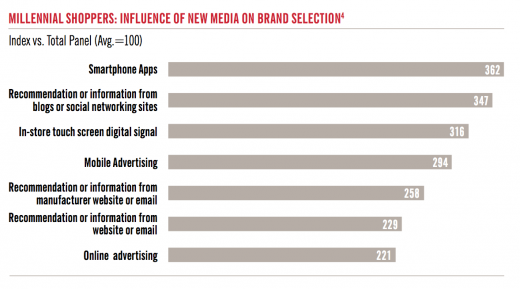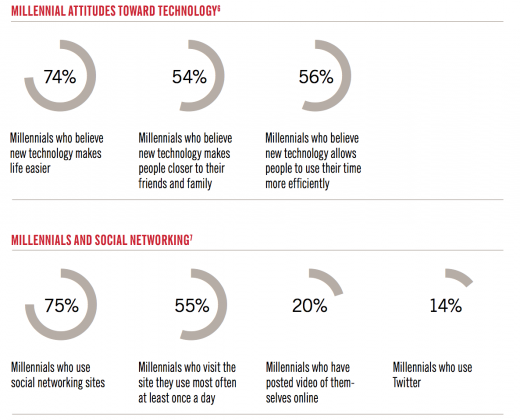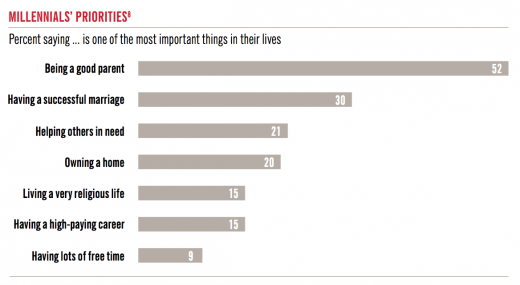
Jamie Gailewicz oversees the Bailey Brand Consulting Client Services team, where he is involved in the ongoing management of clients, delivering sound strategies and inventive solutions.
To sell to any audience, you have to understand it. Discovering how its members think, act, and purchase is only the first step to finding new opportunities to engage with them.
This is especially true of the Millennial generation, the newest target audience for many brands. As their purchasing power increases and the Millennials continue to drive consumer demand, it’s necessary to reevaluate this generation and develop strategies for engaging them.
Each generation has an impact on society. The influence they wield creates social, cultural, and economic effects that impact the world they live in, not to mention the generations before and after them. Their influence also defines how they are perceived—right or wrong—so that various groups, corporations, and organizations can try to understand how to engage them.
Basic statistics about millennials
To reach the Millennials and integrate a brand into their lives, you’ll need to understand the basics. There are roughly 79 million Millennials in the United States—25 percent of the population. The Millennials exceed the number of Baby Boomers (often their parents) by about 3 million.

The Baby Boom generation is a sizable force with significant influence on areas like purchasing power, political direction of the country, and now retirement. Their size has made it easier for them to influence society and grab the attention of corporations and organizations looking to capitalize on their numbers. The Millennials, with their larger population, stand to have equal or greater influence, especially considering differences like wealth, education, and their acceptance of ideas.
Two recessions have impacted Millennials: one at the beginning of the millennium, another in the great recession caused by the sub-prime mortgage crisis in 2009. Both have had a significant impact on their financial confidence and job security, which has affected how they define individual success and spend money.
Ironically, despite two recessions and the limited availability of post-college jobs, they live in households wealthier than the Baby Boomer generation did at the same age. In some cases, Millennials live with other people (such as parents, partners, or friends) to account for higher median household incomes, but the statistic relates to Millennials having the highest college attendance of any generation.
This puts them in a position to generate higher incomes once they start working. At times, they have been compared to the GI generation (Great Depression generation) because they can be viewed as frugal; however, most Millennials see themselves as conscientious with their money, making educated purchases and shunning excess.
Millennials social behaviors
As we slowly move on from the 2009 recession, Millennials will have greater purchasing power (because of their education) and far more influence (because of their numbers).
The recessions may have shaped how Millennials spend money, but the changes—social and cultural—of another time period have shaped their ideals. Millennials are children of the ’80s and ’90s—most becoming aware of their impact on society in the late ’80s through the early ’90s. They learned about responsibility to the environment, tolerance and acceptance of others, and that an individual can make a difference.
Millennials are the recycling generation, raised on the idea that sorting garbage minimizes waste. They learned about global warming and how dependency on fossil fuels can have a dire effect on the world. They were taught to be conscientious of what they consume and how they live in a way that generations before them were not.
The Millennials saw women (including their mothers) impact the workforce, dispelling the misconception that women are limited to either a career or a family. Rather, they could have both while also climbing the corporate ladder. They saw women achieve a greater voice in society and were raised on the idea that everyone is equal regardless of sex or race. They were educated on the injustices of the past and began to see more racial integration in their everyday lives.
For other generations, this idea was new and centered on the idea of “learning to accept.” For Millennials, this is the norm that governs how people should live together in society. We see the effects of these beliefs today with the approval of gay rights and more instances of interracial dating and marriage than ever before.
Millennials and technology
More than any other generation, Millennials rely on each other, sharing opinions with friends to make more informed decisions. They have technology at their fingertips (smartphones) and a number of platforms by which they communicate (Facebook, Instagram, Twitter, etc.).
Social media has transformed how this generation shares its thoughts and extends its influence over others. Stars, Likes, and comments have given them power to share their opinions and pass judgment on the things they approve and disapprove.
Whether supporting a cause, offering an opinion about a product, or simply giving their support to a political figure, Millennials know their voice has power—and they are wielding it.

It should be no surprise that this generation uses social media and various devices that connect to that world at higher levels than other generations. They have the highest numbers of early adoption of new technology compared to past generations.
Tablets, smartphones, and laptops have given them freedom to access what they need when they need it and have helped them become multi-taskers. Television is a multi-dimensional experience for them: they may watch a show while texting friends about the plot lines and shopping for an outfit they see on their favorite character. They find value in these robust experiences—enjoying something on their own while simultaneously sharing it with their friends.
Instant gratification is a common theme with the Millennial. Increased accessibility has created an expectation that Millennials can have whatever they want whenever they want it. This notion does not have to be limited to the digital world.
Millennials still make in-store purchases, but they often shop online as well, and the lines between the two are becoming increasingly blurred. Timely gratification is important. This group looks for speed, ease of purchase, and efficiency when choosing a shopping destination.
Brands that have a social media presence, manage a user-friendly website, and engage their customers with relevant, fresh content have a greater chance to impact Millennial purchasing decisions.
Creating a forum for this group to communicate and share their opinions with each other can create loyal followers and increase sales. However, if a brand’s offering does not satisfy their needs, the judgment they pass can make or break its adoption and success.
Catering to the Millennial consumer profile
Ongoing engagement is necessary to keep Millennials interested and feeling like the brand is adding value to their lives. If you draw correlations to the high education levels of this group, you might assume that their hunger for knowledge drives their choice of brands. Studies have shown that Millennials don’t like brands that explicitly “sell” to them; but brands that sell by providing new, robust, relevant information will have more success and create repeat engagement.
Brands offering content that enhances a product or service while tapping into other Millennial interests gives more dimension to the brand’s relevance. For example, when a brand engages a cause its audience values or provides ways to use a product to enhance an experience, that brand has added significant value for the Millennial consumer.
Some food and spirit brands provide content to help Millennials create the perfect restaurant-quality meal or host a social gathering using the brand’s product. The brands that adopt this strategy position themselves as an asset to the Millennials’ needs or wants, allowing them to become more than their products and services—they become the provider of an experience that this generation wants.
Brands that provide more depth or substance to their offerings and give greater explanations of why they are relevant give the Millennial more reason to make them a part of their lives. And it gives them more reason to share with others, helping the brand build an organic and loyal following. Open, ongoing, relevant communication is the key to a brand’s success with this generation.
Underlying insights
The challenge for any brand is to determine what is relevant for the Millennial audience, which harkens back to their ideals and social dynamics. Having a Facebook account, posting on Twitter, and providing content is critical, but there are many brands that do this with limited success.
There are 79 million Millennials in the United States that have different tastes, desires, and goals. Some believe that buying organic products has a direct benefit to help them achieve a healthy lifestyle; others seek portable grab-and-go solutions that don’t take time out of their day; still others appreciate both.
There are Millennial parents who are constantly seeking new ideas to improve, simplify, and help define their parenting style. Trying to find the commonalities may be difficult, but there are some underlying insights that can be leveraged:
1) Value
Quality is important to the Millennial, but the price must still be fair. The catch, of course, is defining “fair.” Something that is expensive to one person may be cheap to another, and it may have no correlation to income. This reflects the value an individual puts on the item and how it fits into his or her lifestyle.
In truth, most consumers think this way, and the concept of affordable luxury stems from it. A pair of shoes may be overpriced for one person, while another may see them as a necessary accessory. People who don’t see value in the shoes may put their money into a piece of technology, priced similarly to the shoes, but more targeted toward their needs.
It’s not a revolutionary thought, but with a generation that is very conscientious about how it spends money, it is critical for brands to make sure their products and services speak to their quality and relevancy. Brands that have a robust backstory or a unique proposition that gives credibility to their products and services should promote that information to this audience.
2) Relevancy
Making it “their own” is another trait of Millennial consumers. The information Millennials pull from to make choices is vast; they are constantly exposed to and influenced by diverse experiences.
The global connections created by the Web have developed a larger market of choices, and new products and services are being invented so rapidly that part of the fun for this generation is discovering them. Once they find these items, they quickly share them with like-minded friends and recommend them to the world, building a following.
An example is how this generation makes parenting choices. Other generations would rely mostly on their parents to provide insight on how to care for children. They might talk to a friend to get more thoughts, but even so, advice was almost always limited to people they knew.
Millennials still get advice from parents and friends, but they are also influenced by people all over the world. Access to global ideas, knowledge, and personal experiences help give them different perspectives. They pick and choose from the information available to them to create the style of parenting that suits their needs and reflects their values.
Millennials know they have a breadth of available choices, and they rely on feedback from others to help them make their choices. Brands don’t have to be progressive or retro to be adopted, they just have to be relevant and prove their effectiveness to the Millennial audience.
3) Authenticity
The last insight, critical to marketing to this generation, is accepting that it has more choices than any other. The volume of media thrown into today’s market creates a tremendous amount of noise for this generation to contend with—noise that is easily dismissed as differentiation becomes more difficult.
As William Irwin Thompson sees it, “In this world of information overload, the benumbed citizen no longer reads or thinks; he watches and feels.”
This is not, however, the whole truth.
The Millennials do watch and feel, but they still read and think; combining all these experiences allows them to make thoughtful choices. They have been taught to expect more and challenge the ideas that are presented to them.
To break through the noise, marketing efforts (as well as the products and services they represent) must have substance and authenticity to be respected by the Millennial. If something doesn’t resonate or is oversold, chances are they won’t adopt it. Understand their spirit, respect their intelligence, and give them something to be inspired about, and your brand has a fighting chance.
Conclusion
The Millennials, like any generation, are influenced by the culture and world developing around them. Technology and changing social dynamics have a profound effect on their beliefs and actions.
To dismiss them as simply arrogant, lazy, or over-opinionated overlooks what makes them special and different from other generations. This group will challenge, expect more, and desire a better idea for how to live: Ignoring them may well lead to the demise of your brand. This generation is just realizing its purchasing power; as another decade passes, the brands they have built relationships with today will be the ones they are loyal to tomorrow.
Besides, learning to market to this generation will better prepare your brand for the next—who, at the age of one, are already using iPads and being influenced by the world at speeds so far ahead of other generations that it’s hard to imagine what their values will be.
Get the TNW newsletter
Get the most important tech news in your inbox each week.








